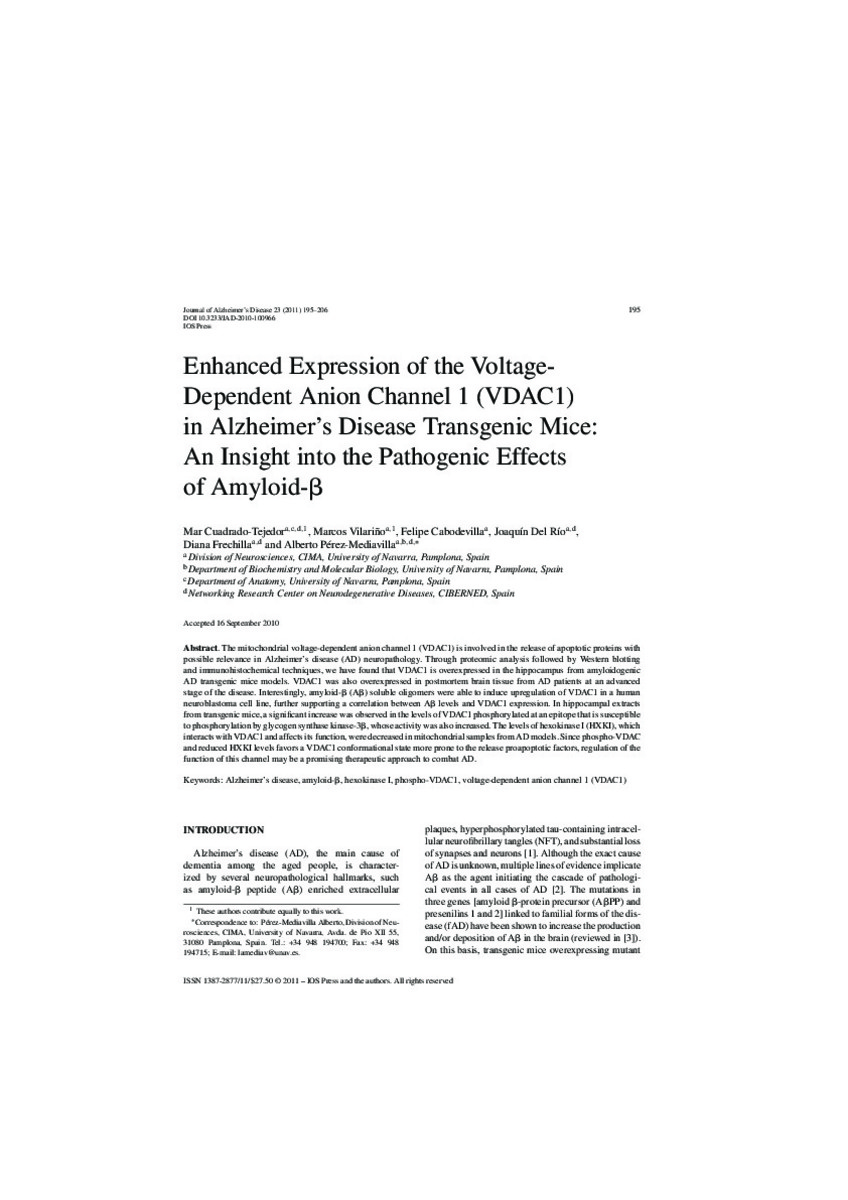Full metadata record
| DC Field | Value | Language |
|---|---|---|
| dc.creator | Cuadrado-Tejedor, M. (Mar) | - |
| dc.creator | Vilariño, M. (Marcos) | - |
| dc.creator | Cabodevilla, F. (Felipe) | - |
| dc.creator | Rio, J. (Joaquín) del | - |
| dc.creator | Frechilla, D. (Diana) | - |
| dc.creator | Perez-Mediavilla, L.A. (Luis Alberto) | - |
| dc.date.accessioned | 2011-11-09T12:17:53Z | - |
| dc.date.available | 2011-11-09T12:17:53Z | - |
| dc.date.issued | 2011 | - |
| dc.identifier.citation | Cuadrado-Tejedor M, Vilariño M, Cabodevilla F, Del Rio J, Frechilla D, Perez-Mediavilla A. ""Enhanced expression of the voltage-dependent anion channel 1 (VDAC1) in Alzheimer's disease transgenic mice: an insight into the pathogenic effects of amyloid-β"". J Alzheimers Dis. 2011 23(2):195-206. | es_ES |
| dc.identifier.issn | 1387-2877 (Print);1875-8908 (Online) | - |
| dc.identifier.uri | https://hdl.handle.net/10171/19472 | - |
| dc.description.abstract | The mitochondrial voltage-dependent anion channel 1 (VDAC1) is involved in the release of apoptotic proteins with possible relevance in Alzheimer's disease (AD) neuropathology. Through proteomic analysis followed by Western blotting and immunohistochemical techniques, we have found that VDAC1 is overexpressed in the hippocampus from amyloidogenic AD transgenic mice models. VDAC1 was also overexpressed in postmortem brain tissue from AD patients at an advanced stage of the disease. Interestingly, amyloid-β (Aβ) soluble oligomers were able to induce upregulation of VDAC1 in a human neuroblastoma cell line, further supporting a correlation between Aβ levels and VDAC1 expression. In hippocampal extracts from transgenic mice, a significant increase was observed in the levels of VDAC1 phosphorylated at an epitope that is susceptible to phosphorylation by glycogen synthase kinase-3β, whose activity was also increased. The levels of hexokinase I (HXKI), which interacts with VDAC1 and affects its function, were decreased in mitochondrial samples from AD models. Since phospho-VDAC and reduced HXKI levels favors a VDAC1 conformational state more prone to the release proapoptotic factors, regulation of the function of this channel may be a promising therapeutic approach to combat AD. | es_ES |
| dc.language.iso | eng | es_ES |
| dc.publisher | IOS Press | es_ES |
| dc.rights | info:eu-repo/semantics/openAccess | es_ES |
| dc.subject | Alzheimer’s disease | es_ES |
| dc.subject | amyloid-beta | es_ES |
| dc.subject | hexokinase I | es_ES |
| dc.subject | phospho-VDAC1 | es_ES |
| dc.subject | voltage-dependent anion channel 1 (VDAC1) | es_ES |
| dc.title | Enhanced expression of the voltage-dependent anion channel 1 (VDAC1) in Alzheimer's disease transgenic mice: an insight into the pathogenic effects of amyloid-β | es_ES |
| dc.type | info:eu-repo/semantics/article | es_ES |
| dc.identifier.doi | http://dx.doi.org/10.3233/JAD-2010-100966 | es_ES |
Files in This Item:
Statistics and impact
Items in Dadun are protected by copyright, with all rights reserved, unless otherwise indicated.






